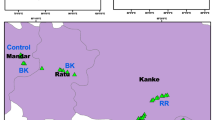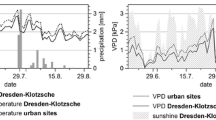Abstract
The mitigation potential of avenue tree species needs a sound understanding, especially for landscape planning or planting tree species on roadside, especially in city limits where there is huge traffic due to more number of vehicles. A preliminary study was conducted to investigate the impact of heavy traffic movement and pollution thereof on physiological functioning of Lagerstroemia speciosa trees planted on roadside in terms of carbon absorption, mitigation potential and adaptive behavior. Trees on roadside exhibited reduced carbon assimilation (36.7 ± 2.4%) and transpiration rate (42.14 ± 2.9%), decreased stomatal conductance (66.85 ± 3.87%), increased stomatal resistance (212.2 ± 11.25%), more leaf thickness (40.54 ± 3.25) and water use efficiency (9.4 ± 0.87%), and changes in lead (179.31 ± 10.24%) and proline (15.61 ± 1.92%) concentration in leaf tissues when compared to less traffic area (FRI campus). The impacts were also witnessed in the form of enhanced vapour pressure deficit of air (63.18 ± 4.94%) and leaf (45.72 ± 3.25%), and air temperature (3.2 ± 0.16%) and leaf temperature (9.0 ± 0.82%) along roadside trees. It was inferred that heavy traffic movements interrupt the physiological functioning of trees due to alteration in the surrounding environment as compared to non-traffic areas. The present study provides baseline information to further explore and identify the potential avenue tree species having significant mitigation potential and adaptive efficiency to heavy traffic movements for improving urban environment.






Similar content being viewed by others
References
Agbaire OP (2016) Impact of air pollution on proline and soluble sugar content of selected plant species. Chem Mater Res 8:72–76
Andersson-Skold Y, Thorsson S, Rayner D, Lindberg F, Janhall S, Jonsson A, Moback U, Bergman R, Granberg M (2015) An integrated method for assessing climate related risks and adaptation alternatives in urban areas. Clim Risk Manag 7:31–50
Bates LS, Waldern RP, Teave ID (1973) Rapid determination of free proline for water stress studies. Plant Soil 39:205–209
Bojarczuk K, Karolewski P, Oleksyn J, Kieliszewska-Rokicka B, Żytkowiak R, Tjoelker MG (2002) Effect of polluted soil and fertilization on growth and physiology of silver birch (Betula pendula Roth.) seedlings. Pol J Environ Stud 11:483–492
Calfapietra C, Penuelas J, Niinemets U (2015) Urban plant physiology: adaptation–mitigation strategies under permanent stress. Trends Plant Sci 20:72–75
Chaturvedi RK, Prasad S, Rana S, Obaidullah SM, Pandey V, Singh H (2013) Effect of dust load on the leaf attributes of the tree species growing along the roadside. Environ Monit Assess 185:383–391
Chauhan A (2010) Photosynthetic pigment changes in some selected trees induced by automobile exhaust in Dehradun, Uttarakhand. New York Sci J 3:45–51
Cochran WG, Cox GM (1957) Experimental designs, 2nd edn. Wiley, New York
Cui HX, Jiang GM, Niu SL, Jiang CD, Liu MZ, Yu SL, Ming GL (2006) Ecophysiological response of plants to combined pollution from heavy-duty vehicles and industrial emission in higher humidity. J Integr Plant Biol 48:1391–1400
Dong J, Wu F, Gui HR, Zang GP (2007) A chromium tolerant plant growing in Cr-contaminated land. J Phytorem 9:167–179
Durrani GF, Hassan M, Baloch MK, Hameed G (2004) Effect of traffic pollution on plant photosynthesis. J Chem Soc Pak 26:176–179
Eller BM (1977) Road dust induced increase of leaf temperature. Environ Pollut 13:99–107
Emberson L, Ashmore M, Murray F, Kuylenstierna JCI, Percy KE, Izuta T, Zheng Y, Shimizu H, Sheu BH, Liu J, Agrawal M, Wahid A, Abdel-Latif NM, van Tienhove M, de Bauer LI, Domingos M (2001) Impacts of air pollutants on vegetation in developing countries. Water Air Soil Pollut 130:107–118
Farmer AM (1993) The effects of dust on vegetation—a review. Environ Pollut 79:63–75
Fluckinger W, Oertli JJ, Fluckiger W (1979) Relationship between stomatal diffusive resistance and various applied particle sizes on leaf surface. Z Pflanzenphysiol 91:773–775
Hare PD, Cress WA (1997) Metabolic implication of stress-induced proline accumulation in plants. Plant Growth Reglu 21:79–102
Honour SL, Bell JNB, Ashenden TA, Cape JN, Power SA (2009) Responses of herbaceous plants to urban air pollution: effects on growth, phenology and leaf surface characteristics. Environ Pollut 157:1279–1286
Hope AS, Fleming JB, Stow DA, Aguado E (1991) Tussock tundra albedos on the north slope of Alaska: effects of illumination, vegetation composition and dust deposition. J Appl Meteorol 30:1200–1206
Jackson ML (1965) Soil chemical analysis. Prentice Hall Inc., Englewood Cliffs
Jaleel CA, Manivannan P, Sankar B, Kishorekumar A, Gopi R, Somasundaram R, Panneerselvam R (2007) Water deficit stress mitigation by calcium chloride in Catharanthus roseus; effects on oxidative stress, proline metabolism and indole alkaloid accumulation. Colloids Surf B Biointerfaces 60:110–116
Janhall S (2015) Review on urban vegetation and particle air pollution—deposition and dispersion. Atmos Environ 105:30–137
Jochner S, Markevych I, Beck I, Traidl-Hoffmann C, Heinrich J, Menzel A (2015) The effects of short- and long-term air pollutants on plant phenology and leaf characteristics. Environ Pollut 206:382–389
Kardel F, Wuyts K, Babanezhad M, Vitharana UWA, Wuytack T, Potters G, Samson R (2009) Assessing urban habitat quality based on specific leaf area and stomatal characteristics of Plantago lanceolata L. Environ Pollut 158:288–794
Kavi KPB, Sangam S, Amrutha RN, Laxmi PS, Naidu KR, Roa KRS, Reddy KJ, Theriappan P, Screenivasulu N (2005) Regulation of proline biosynthesis, degradation, uptake and transport in higher plants, its implication in plants growth and abiotic stress tolerance. Curr Sci 88:424–438
Keller J, Lamprecht R (1995) Road dust as an indicator for air pollution transport and deposition: an application of SPOT imagery. Remote Sens Environ 54:1–12
Khedhar DD, Gadge VD (2014) Effect of air pollution on metabolic contents of some tress in Amravati (MS). J Aquat Biol Fish 2:260–264
Kupper P, Sõber J, Sellin A, Lõhmus K, Tullus A, Räim O, Lubenets K, Tulva I, Uri V, Zobel M, Kull O, Sõber A (2011) An experimental facility for free air humidity manipulation (FAHM) can alter water flux through deciduous tree canopy. Environ Exp Bot 72:432–438
Leghari SK, Zaidi MA, Sarangzai FM, Shawani GR, Ali W (2013) Effect of road side dust pollution on the growth and total chlorophyll contents in Vitis vinefera L. Afr J Biotechnol 13:1237–1242
Li MH (2003) Peroxidase and superoxide dismutase activities in fig leaves in response to ambient air pollution in a subtropical city. Arch Environ Contam Toxicol 45:168–176
Liu YJ, Ding H (2008) Variation in air pollution tolerance index of plant near a steel factory: implication for landscape-plant species selection for industrial areas. WSEAS Trans Environ Dev 4:24–32
Medrano H, Tomás M, Martorell S, Flexas J, Hernández E, Rosselló J, Pou A, Escalona J, Bota J (2015) From leaf to whole-plant water use efficiency (WUE) in complex canopies: limitations of leaf WUE as a selection target. Crop J 3:220–228
Mohammadkhani N, Heidar R (2008) Drought-induced accumulation of soluble sugar and proline in two maize varieties. World Appl Sci J 3:448–453
Moura BB, Alves ES (2014) Climatic factors influence leaf structure and thereby affect the ozone sensitivity of Ipomoea nil ‘Scarlet O’Hara’. Environ Pollut 194:11–16
Nagajyoti PC, Lee KD, Sreekanth TVM (2016) Heavy metals, occurrence and toxicity for plants: a review. Environ Chem Lett 8:199–216
Naidoo G, Chirkoot D (2004) The effect of coal dust on photosynthetic performance of the mangrove, Avicennia marine in Richards’s bay, South Africa. Environ Pollut 127:359–366
Narwaria YS, Kush K (2012) Environmental assessmentof air pollution on roadside plants species at Dehradun, Uttrakhand, India. J Environ Res Dev 7:710–714
Ozturk LD, Denir Y (2002) In vivo and in vitro protective role of proline. Plant Growth Regul 38:259–264
Panda LS, Rai PK (2015) Roadside plants e study on eco-sustainability. Lambert Publisher, Germany
Parveen S, Iqbal MZ, Shafiq M, Athar M (2014) Effect of automobile polluted soil on early seedling growth performance of Neem (Azadirachta indica A. Juss.). Adv Environ Res 3:1–9
Prajapati SK, Tripathi BD (2008) Seasonal variation of leaf dust accumulations and pigment content in plant species exposed to urban particulates pollution. J Environ Qual 37:865–870
Rai PK (2013) Environmental magnetic studies of particulates with special reference to bio-magnetic monitoring using roadside plant leaves. Atmos Environ 72:113–129
Rai PK, Panda LS (2015) Roadside plants as bio indicators of air pollution in an industrial region, Rourkela, India. Int J Adv Res Technol 4:19–41
Rai A, Kulshreshtha K, Srivastava PK, Mohanty CS (2010) Leaf surface structure alterations due to particulate pollution in some common plants. Environmentalist 30:18–23
Salazar MJ, Pignata ML (2014) Lead accumulation in plants grown in polluted soils. Screening of native species for phytoremediation. J Geochem Explor 137:29–36
Seyyednejad SM, Koochak H (2011) A study on air pollution effect on Eucalyptus camoldulensis. Int Conf Environ Biomed Biotechnol 16:98–101
Singh H (2015) AICP on elevated CO2. A project completion report submitted to Indian Council of Forestry Research and Education, Dehradun, 156 pp
Singh R, Barman SC, Negi MPS, Bhargava SK (2008) Metals concentration associated with respirable particulate matter (PM10) in industrial area of eastern U.P., India. J Environ Biol 29:63–68
Stanghellini C, van Meurs WTM (1992) Environmental control of greenhouse crop transpiration. J Agric Eng Res 51:297–311
Tripathi BD, Pathak V, Mishra VK (2011) Evaluation of Anticipated Performance Index of some tree species for green belt development to mitigate traffic generated noise. Urban For Urban Green 10:61–66
Verbruggen N, Hermans C (2008) Proline accumulation in plants: a review. Amino Acids 35:753–759
Wagela DK, Pawar K, Dube B, Joshi OP (2002) Lead monitoring in air, soil and foliar deposits at Indore city with special reference to automobile pollution. J Environ Biol 23:417–421
Wittenberghe SV, Alonso L, Verrelst J, Hermans I, Delegido J, Veroustraete F, Valcke R, Moreno J, Samson R (2013) Upward and downward solar-induced chlorophyll fluorescence yield indices of four tree species as indicators of traffic pollution in Valencia. Environ Pollut 173:29–37
Yancey PH, Clark ME, Hand SC, Bowlus RD, Somero GN (1982) Living with water stress: evolution of osmolyte systems. Science 217:1214–1222
Author information
Authors and Affiliations
Corresponding author
Ethics declarations
Conflict of interest
The authors declare that they have no conflict of interest in the publication.
Rights and permissions
About this article
Cite this article
Singh, H., Savita, Sharma, R. et al. Physiological functioning of Lagerstroemia speciosa L. under heavy roadside traffic: an approach to screen potential species for abatement of urban air pollution. 3 Biotech 7, 61 (2017). https://doi.org/10.1007/s13205-017-0690-0
Received:
Accepted:
Published:
DOI: https://doi.org/10.1007/s13205-017-0690-0




